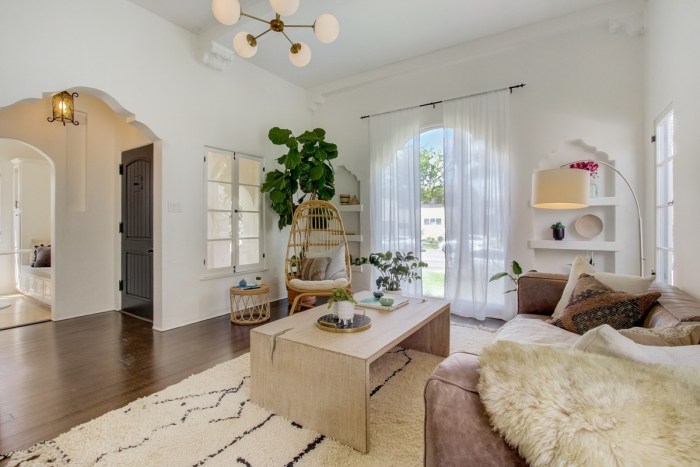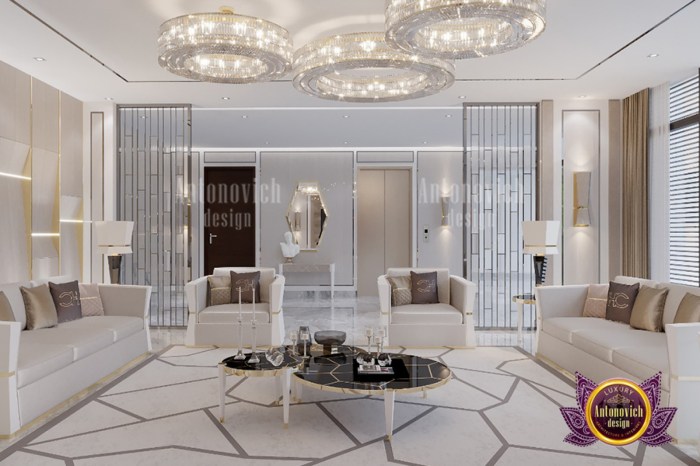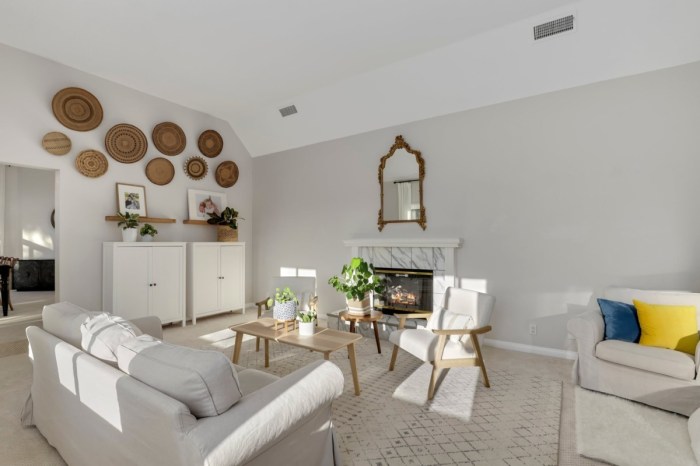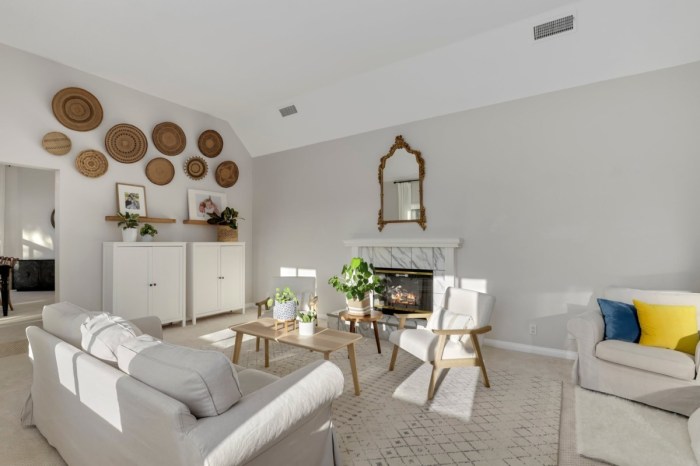Bungalow house interior design ideas offer a unique opportunity to create a warm and inviting space that reflects the charm and simplicity of this architectural style. Bungalows, with their low-pitched roofs, wide porches, and open floor plans, have long been associated with a sense of relaxation and connection to nature.
This guide explores the essential elements of bungalow design, providing inspiration for transforming your bungalow into a cozy and stylish haven.
From embracing natural materials and textures to incorporating functional and stylish furniture, we’ll delve into the key principles that define bungalow interiors. We’ll also explore modern interpretations of bungalow design, offering tips for maximizing space in smaller bungalows and incorporating sustainable practices.
Whether you’re starting from scratch or looking to refresh your existing bungalow, this guide will provide you with the tools and inspiration to create a home that truly reflects your personality and style.
Creating a Welcoming and Cozy Atmosphere

Bungalows are known for their charming and inviting atmosphere, and maximizing this quality is a key aspect of bungalow interior design. Creating a welcoming and cozy ambiance in your bungalow involves careful consideration of furniture placement, lighting, and decor.
Maximizing Space and Flow in a Bungalow Living Room
A well-designed living room layout in a bungalow prioritizes functionality and flow. The limited space necessitates smart furniture choices and strategic placement.
- Utilize multi-functional furniture:Consider pieces like a sofa bed or a coffee table with built-in storage to maximize space and functionality.
- Open floor plan:If possible, open up the space between the living room and other areas, like the kitchen or dining room, to create a sense of openness.
- Strategic furniture placement:Avoid blocking walkways and create visual pathways that draw the eye through the room. Place furniture against walls to free up floor space and create a sense of spaciousness.
- Mirrors:Mirrors can create the illusion of more space and reflect light, brightening the room. Place a large mirror opposite a window to maximize natural light.
Using Natural Light to Enhance the Bungalow’s Interior
Natural light plays a crucial role in creating a welcoming and airy atmosphere.
- Maximize window exposure:Remove any obstructions blocking natural light from entering the bungalow. Consider using sheer curtains or blinds that allow light to filter through.
- Light colors:Choose light and neutral colors for walls and furniture to reflect light and create a brighter, more spacious feeling.
- Strategic lighting:Use a combination of natural and artificial light to create a balanced and inviting atmosphere. Place lamps strategically to highlight key areas and create cozy reading nooks.
Organizing a Bedroom Space for Tranquility and Comfort
A well-organized bedroom creates a sense of tranquility and comfort, promoting relaxation and restful sleep.
Bungalow house interior design often embraces a cozy and inviting atmosphere. Creating a welcoming space can involve incorporating warm colors, natural textures, and comfortable seating. For a unique touch, consider drawing inspiration from the world of beer house interior design , where rustic elements and industrial accents often create a charming ambiance.
This can be achieved through exposed brick walls, reclaimed wood furniture, and vintage lighting fixtures, bringing a touch of character to your bungalow’s interior.
- Minimalist approach:Declutter the bedroom by removing unnecessary items and storing belongings in drawers, closets, or under the bed.
- Calming color palette:Choose calming colors for walls and bedding, such as soft blues, greens, or neutrals. Avoid stimulating colors like bright reds or yellows.
- Comfortable bedding:Invest in high-quality bedding that feels luxurious and inviting. A plush duvet, soft sheets, and comfortable pillows will enhance sleep quality.
- Create a relaxing ambiance:Add elements that promote relaxation, such as a comfortable armchair, a bedside table with a good book, or a diffuser with calming essential oils.
Bringing in Outdoor Elements
Bungalows, with their close connection to nature, are perfect for seamlessly blending indoor and outdoor spaces. Bringing in outdoor elements can create a sense of openness and freshness, further enhancing the bungalow’s inviting ambiance.
Plants and Greenery
Plants and greenery are essential for bringing the outdoors in. They not only add visual interest and texture but also purify the air, creating a healthier and more invigorating environment.
- Consider placing large potted plants in corners or near windows to create a natural room divider or focal point.
- Hanging plants from the ceiling or placing them on shelves can add vertical interest and bring life to otherwise empty spaces.
- Use trailing plants to soften sharp edges or create a cascading effect over furniture.
- A small herb garden on a windowsill can add a touch of practicality and fragrance to the kitchen.
Designing a Patio or Porch Area
A well-designed patio or porch area can be an extension of the bungalow’s living space, providing an inviting space for relaxation and entertaining.
- Choose furniture that complements the bungalow’s style and provides comfortable seating for guests.
- Incorporate natural materials like wood, stone, or wicker to enhance the outdoor feel.
- Add a fire pit or outdoor fireplace for cozy evenings.
- Use lighting to create a warm and inviting atmosphere at night.
- Consider adding a water feature, such as a small fountain or pond, for a calming and relaxing ambiance.
Adding Personal Touches

A bungalow’s charm lies in its ability to reflect the personality of its inhabitants. Adding personal touches through artwork, accessories, and vintage elements transforms a house into a home, creating a space that feels uniquely yours.
Incorporating Artwork and Accessories
Personalizing a bungalow interior with artwork and accessories is an excellent way to showcase your interests and style.
- Hang Local Artwork:Local art, whether paintings, prints, or photographs, adds a touch of authenticity and connects the space to its surroundings. For example, a landscape painting depicting a nearby scene or a photograph capturing the local architecture adds a sense of place.
- Display Family Heirlooms:Family heirlooms, such as antique clocks, vintage photographs, or hand-stitched quilts, tell stories and create a sense of history within the bungalow. These items evoke memories and create a warm, welcoming atmosphere.
- Utilize Bold Colors:Inject personality through bold, vibrant colors in accessories such as throw pillows, rugs, or curtains. These elements can create focal points and add a playful touch to the bungalow’s interior.
- Incorporate Travel Souvenirs:Travel souvenirs, such as woven baskets, handcrafted ceramics, or framed postcards, can bring a touch of global inspiration to the bungalow. These items act as conversation starters and remind you of your adventures.
Utilizing Vintage and Antique Elements
Vintage and antique elements can enhance the bungalow’s character, adding a touch of nostalgia and charm.
- Vintage Furniture:Reclaimed or restored vintage furniture, such as a mid-century modern armchair or a vintage dining table, can add character and a sense of history to the bungalow. These pieces often have unique details and craftsmanship that complement the bungalow’s aesthetic.
- Antique Lighting Fixtures:Antique lighting fixtures, such as a vintage chandelier or a pair of sconces, can create a warm and inviting ambiance. These fixtures often feature intricate details and materials that add a touch of elegance to the bungalow.
- Vintage Textiles:Vintage textiles, such as antique rugs, woven tapestries, or hand-stitched quilts, can add texture and warmth to the bungalow. These items often feature unique patterns and colors that complement the bungalow’s style.
- Antique Accessories:Antique accessories, such as vintage clocks, antique books, or vintage mirrors, can add a touch of personality and history to the bungalow. These items can be used to create focal points or to fill empty spaces.
Organizing a Bungalow-Style Decor Collection, Bungalow house interior design ideas
Curating a collection of bungalow-style decor items can enhance the bungalow’s character and create a cohesive design.
- Choose a Theme:Consider a theme that resonates with your personal style, such as coastal, farmhouse, or bohemian. This theme will guide your selection of decor items and create a cohesive look.
- Mix and Match Styles:Don’t be afraid to mix and match different styles to create a unique and eclectic look. For example, you could combine vintage furniture with modern accessories or rustic elements with contemporary art.
- Create Focal Points:Use statement pieces, such as a large rug, a unique lamp, or a collection of framed photographs, to create focal points in the bungalow. These elements draw attention and add visual interest to the space.
- Embrace Imperfections:Embrace imperfections in your decor items, as they add character and authenticity to the bungalow. A chipped antique vase or a vintage rug with faded colors can tell a story and add a touch of charm.
Modern Bungalow Style: Bungalow House Interior Design Ideas

The bungalow, a beloved architectural style that emerged in the early 20th century, continues to captivate homeowners with its charming simplicity and cozy atmosphere. While traditional bungalows often feature rustic details and a focus on natural materials, modern interpretations offer a fresh perspective, blending classic bungalow features with contemporary design elements.
Comparing Traditional and Modern Bungalow Design
The modern bungalow style embraces the core principles of the traditional bungalow while incorporating contemporary design trends. Here’s a comparison of key features:
- Traditional Bungalow:Characterized by low-pitched roofs, wide eaves, and a focus on natural materials like wood and stone. Often features exposed beams, built-in cabinetry, and a connection to the outdoors.
- Modern Bungalow:Retains the low-pitched roof and emphasis on natural light but incorporates sleek lines, minimalist aesthetics, and modern materials like concrete, metal, and glass. Open floor plans and a focus on functionality are also common.
Key Elements of Modern Bungalow Interiors
Modern bungalow interiors are characterized by a balance of classic and contemporary elements, creating a space that is both stylish and welcoming. Key elements include:
- Open Floor Plan:Modern bungalows often feature open floor plans that seamlessly connect the living, dining, and kitchen areas. This creates a sense of spaciousness and allows for natural light to flow throughout the home.
- Natural Light:Large windows and skylights are essential for bringing in ample natural light, which is a defining feature of bungalow homes. This helps to create a bright and airy atmosphere.
- Neutral Color Palette:Modern bungalows often feature a neutral color palette, with white, gray, and beige serving as the foundation. This provides a clean and contemporary backdrop for pops of color through furniture, artwork, and accessories.
- Sleek and Minimalist Furniture:Modern bungalows often feature sleek and minimalist furniture with clean lines and simple shapes. This helps to create a sense of order and space.
- Natural Materials:While incorporating modern materials like concrete and metal, modern bungalows still embrace the use of natural materials such as wood, stone, and leather. These elements add warmth and texture to the space.
Designing a Contemporary Bungalow Living Room
Here’s an example of how to create a contemporary bungalow living room that blends modern elements with classic bungalow features:
- Start with a neutral color palette:Choose a base color like white or light gray for the walls and furniture. This will create a clean and spacious feel.
- Incorporate natural materials:Use wood flooring or a wood coffee table to add warmth and texture. A stone fireplace or accent wall can also enhance the natural element.
- Embrace open space:Keep the layout open and airy by using furniture that doesn’t block the flow of traffic. Consider using a sofa with low legs or a sectional that can be arranged to create a conversation area.
- Add pops of color:Introduce pops of color through throw pillows, artwork, and rugs. You can choose colors that complement the natural materials and create a cohesive look.
- Focus on functionality:Choose furniture that serves a purpose and is both stylish and practical. For example, a storage ottoman can double as seating and provide extra storage.
Small Bungalow Interior Design
Bungalows, with their charming character and cozy atmosphere, often come in smaller sizes. Maximizing space in a small bungalow is key to creating a comfortable and functional home. This section will explore tips and tricks for making the most of every square foot.
Maximizing Space in a Small Bungalow
Small bungalows can feel cramped, but with clever design choices, you can create an illusion of spaciousness. Here are some tips:
- Use Mirrors:Mirrors strategically placed can reflect light and create a sense of depth, making a room appear larger.
- Choose Light Colors:Lighter colors on walls and furniture make a room feel more open and airy.
- Embrace Multi-Functional Furniture:Opt for pieces that serve multiple purposes, like a sofa bed or a coffee table with storage.
- Declutter Regularly:Minimalism is key in small spaces. Regularly decluttering and organizing will prevent a cluttered look.
- Vertical Storage:Utilize vertical space with shelves, tall cabinets, and wall-mounted organizers to maximize storage.
Designing a Compact Kitchen Layout
A small bungalow kitchen can be both functional and stylish. Here are some design ideas:
- Open Shelving:Open shelving can add visual interest and save on cabinet space. Choose attractive dishes and cookware to display.
- Island or Peninsula:A small island or peninsula can provide extra counter space and seating. Consider a design that incorporates storage or a sink.
- Built-in Appliances:Built-in appliances like ovens and refrigerators can save space and create a streamlined look.
- Light and Bright:Use light colors on walls and cabinets to make the kitchen feel larger and more inviting.
- Compact Appliances:Consider smaller appliances like a mini-fridge or a compact dishwasher to save space.
Organizing a Small Bathroom
Creating a sense of spaciousness in a small bathroom is essential for a relaxing experience. Here are some ideas:
- Floating Vanities:Floating vanities create a sense of airiness and make the bathroom feel larger.
- Glass Shower Doors:Glass shower doors allow light to pass through, making the bathroom feel more open.
- Vertical Storage:Utilize vertical space with shelves, cabinets, and wall-mounted organizers to keep toiletries and towels organized.
- Minimalist Decor:Keep the decor simple and minimal to avoid a cluttered look.
- Light Colors:Use light colors on walls and tiles to create a sense of spaciousness.
Bungalow Interior Design Inspiration
Drawing inspiration from successful bungalow interiors can be a great way to jumpstart your own design process. Exploring various styles and design principles can help you envision the cozy and welcoming atmosphere you desire for your bungalow.
Bungalow house interior design ideas can be truly versatile. A classic approach is to embrace a minimalist aesthetic, and what better way to achieve this than with a striking black and white color scheme? This timeless combination can be effortlessly incorporated into any bungalow, creating a sense of sophistication and elegance.
If you’re looking for inspiration on how to pull off this design trend, check out this article on black white house interior design. From bold statement pieces to subtle accents, black and white can be used to enhance the bungalow’s charm and create a truly captivating space.
Examples of Well-Designed Bungalow Interiors
The following table showcases a few examples of well-designed bungalow interiors, highlighting their unique features and design elements:
| Image | Description | Design Principles |
|---|---|---|
| A bungalow with a light and airy living room, featuring large windows, a white color scheme, and a mix of modern and traditional furniture. | This bungalow features a light and airy living room, characterized by large windows that flood the space with natural light. The white color scheme enhances the sense of spaciousness, while the mix of modern and traditional furniture adds a touch of eclecticism. | – Maximizing Natural Light: Large windows and a light color scheme enhance the sense of spaciousness and brightness.
Blending Styles Mixing modern and traditional furniture creates a unique and eclectic look. Open Floor Plan The open floor plan connects the living room to other areas, fostering a sense of flow and connectivity. |
| A bungalow with a cozy and intimate dining room, featuring a rustic wooden table, warm lighting, and a collection of vintage artwork. | This bungalow features a cozy and intimate dining room, characterized by a rustic wooden table that serves as the centerpiece. Warm lighting creates a welcoming ambiance, while the collection of vintage artwork adds a touch of personality and history. | – Creating a Focal Point:The rustic wooden table serves as a focal point, drawing attention and inviting conversation.
Bungalow house interior design often emphasizes cozy, inviting spaces. One way to achieve this is by incorporating elements of bohemian house interior design , with its relaxed, eclectic aesthetic. Think woven textures, vibrant colors, and global-inspired accents. These elements can add a touch of bohemian charm to your bungalow, creating a warm and welcoming atmosphere. Warm Lighting Warm lighting creates a cozy and intimate atmosphere, enhancing the sense of comfort and relaxation. Adding Personal Touches The collection of vintage artwork reflects the homeowner’s personal style and creates a unique character for the space. |
| A bungalow with a modern and minimalist kitchen, featuring sleek cabinetry, stainless steel appliances, and a neutral color palette. | This bungalow features a modern and minimalist kitchen, characterized by sleek cabinetry, stainless steel appliances, and a neutral color palette. The clean lines and simplicity of the design create a sense of order and efficiency. | – Clean Lines and Simplicity:The sleek cabinetry, stainless steel appliances, and neutral color palette create a modern and minimalist aesthetic.
Functional Design The kitchen is designed with functionality in mind, featuring ample storage and workspaces. Neutral Color Palette The neutral color palette provides a backdrop for the sleek cabinetry and stainless steel appliances, creating a sense of harmony and balance. |
End of Discussion
Designing a bungalow interior is an exciting journey of blending functionality with aesthetic appeal.
By embracing the essence of bungalow style, incorporating natural elements, and adding personal touches, you can create a home that is both inviting and uniquely yours. Remember, the key to a successful bungalow interior is to focus on creating a space that feels comfortable, welcoming, and true to your own individual style.
FAQ
What are some common colors used in bungalow interiors?
Bungalow interiors often feature warm, earthy tones like beige, brown, green, and blue. These colors complement the natural materials used in bungalow design and create a sense of warmth and tranquility.
How can I create a sense of flow in a bungalow living room?
Use an open floor plan, minimize clutter, and choose furniture with clean lines and simple designs. You can also use rugs to define different areas within the space and create a sense of visual separation.
What are some sustainable practices for bungalow interior design?
Choose eco-friendly materials like bamboo, reclaimed wood, and natural fibers. Use energy-efficient lighting and appliances. Consider using paint with low VOCs (volatile organic compounds).

